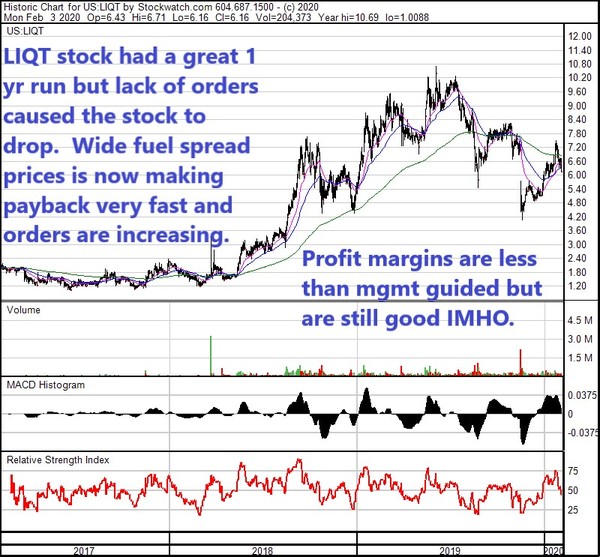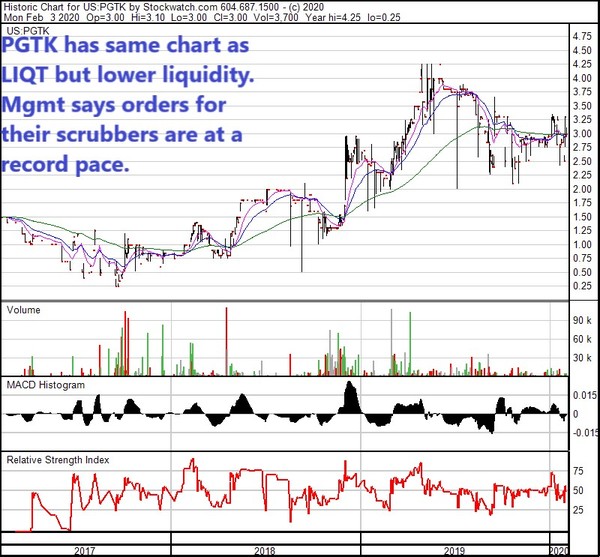IMO 2020 was potentially a big trade in 2019, and is still potentially a big trade in 2020—though I confess I struggle to find any BIG WIN potential.
IMO 2020 stands for the International Marine Organization, a UN body. They have mandated that ships switch to much cleaner and more expensive fuel, starting January 1 2020.
Commercial shipping is incredibly pollutive—one stat I read stated that a cruise ship produces as much pollution a day as one million cars! So this truly is an issue worth pursuing if we want a greener planet.
US brokerage firm Raymond James hosted a big conference call on January 23 2020 to give investors an update on how IMO 2020 was rolling out. They invited Pacific Green Technology CEO Scott Poulter (PGTK-NASD) to speak. PGTK makes a scrubber that ships can use to clean out the dirty ship fuel—which allows ships to continue to buy cheaper, dirtier fuel.
This initiative has mostly been pushed by Asia and Europe (the American gov’t meekly tried to fight it but to a small degree and ended up just followed along) and by all accounts, they are keen to see it enforced in their ports—where a ship not using cleaner fuel cannot come into port.
The Big Winner last year—if you timed it right—was LIQT-NASD; a Danish company called Liqtech. Our subscribers enjoyed a partial ride on their stock run in 2019.

The
company has great technology, but it became clear that the pace of orders from
the shipping industry would not be anywhere near as huge as the Market
guesstimated in early 2019, so I sold the stock and booked my profits. The
stock languished the rest of the year but has recently had a 50% bounce
in six weeks.
Pacific Green is focused emission control technologies. Using their
ENVI-Marine System product, the company installs scrubbers for the shipping
industry.

Over the last year Pacific Green has built up an order book of over 130
scrubber installations – with customers that include the Scorpio Group and
Union Maritime.

Source: Pacific Green Investor Presentation
Poulter was asked to give an update on scrubber dynamics now that IMO 2020 is
here – and now that shipping companies are seeing the impact of the rule
change.
To recap IMO 2020 – This is a new regulation to the shipping industry (that
began January this year) that limits sulphur emission. These limits
restrict the use of HSFO as a fuel source for most ships.
Unless a ship has a scrubber, it can no longer fill its fuel tank with high
sulphur fuel oil (HSFO).
Scrubbers Remain Economic
Poulter cleared up any confusion about the economics of scrubbers – they are even better
than expected for the large ships.
VLCC’s, containerships and other large carriers can see a payback in 5 to 7
months.
This may come as a surprise to some. The recent slide in very-low-sulphur
fuel (VLSFO) prices has led to some questions about whether scrubbers would
turn out to be worthwhile.
But while scrubber economics have narrowed since the beginning of January, they
remain quite favorable.
Throughout most of December, VLSFO prices rocketed to new highs. Since
January prices have fallen back down to earth.

Source: Sinagpore Bunker Prices – Ship &
Bunker
But the reality is that even at current prices, scrubber economics remain in
the black.
The spread at major fuel hubs still eclipses $200 per tonne based on a 60/40
blend of VLSFO and marine gasoil and current HSFO prices.

Source: Ship and Bunker, January 27, 2020 data
Last year shipowners were making the decision to install scrubbers at an
expected spread of ~$150 to $200 per tonne.
Depending on the ship size, this was the price level where payback was between
6 months and 1 year.
DNB Markets put out this handy table of scrubber economics some time ago.
It is still instructive today:

Source: DNB Markets – SHIPPING SECTOR: Scrubbing
up nicely for IMO 2020
The reality is that at current spreads it still is very economic to install
scrubbers on the larger tankers and containerships.
That being said, scrubbers don’t make sense for all ships. Smaller tanker
like MR’s don’t consume enough fuel to make scrubbers attractive.
Also, there remains a risk though that if product demand disappoints, spreads
may tighten further.
VLSFO and another fuel that ships can blend marine gas-oil (MGO) are middle
distillate products that compete for refinery capacity with other fuels – most
notably diesel.
A weakening economy that pulled down the price of other distillates could
continue to squeeze low-sulphur fuel margins.
Poulter Says Demand for Scrubbers Remains Strong
The pop in VLSFO prices in December made many ship owners take notice.
Consequently, scrubber inquiries have picked up now that IMO 2020 is upon us.
Poulter says that Pacific Green has received more scrubber inquires in the past 23 days than they did in all of 2019.
While
smaller ships are less likely to install scrubbers, on a fuel usage basis –
scrubbers are viable for 75% of the fuel consumption of the sector based on a
12 month return on investment.
That makes for a large addressable market for scrubber manufacturers.
Is Compliance Happening?
One
of the uncertainties going into 2020 was compliance. Would ports enforce
the rules?
At one particularly bleak moment Indonesia even went so far as to say they
would explicitly not enforce IMO 2020 at any of their ports (they have
since backtracked on those comments).
According to Poulter, those concerns have diminished. He says they are
seeing–so far–is strong enforcement of compliance at all the major ports.
Even during scrubber installations Poulter says that compliance is closely
checked. When they bring a vessel into the yard for a scrubber retrofit
they are restricted from using HSFO even for the short-trip in.
Instead they have to use gas-oil, and once the scrubber is installed the vessel
has to get an exemption to do sea trials on the scrubber – in other words even
the most minor usage of HSFO is being scrutinized.
Pacific Green works primarily in China where they operate under a joint venture
with Power China. They see that the China government is being “very, very”
strict about the enforcement of the regulations right now.
Long Lead Times
Pacific Green has a 6-month lead time on new scrubber orders but Poulter says
theirs is one of the shortest lead times in the industry.
Because of their JV with Power China, Pacific Green has shipyard capacity that
other installers do not.
What they are seeing from their competitors are up to 12 months of
backlog. On average Poulter believes the backlog for the industry
is around 9 months.
Open-Loop versus Closed Loop
Meanwhile, as restrictions on fuels become strictly enforced, the shift is
being made to scrubbers that do not discharge the effluent water into the
ocean.
Open-loop scrubbers have, in the past, dominated the market – making up around
90% of scrubber installations up until last year. But that has changed.
According to Liqtech (LIQT – NASDAQ) CEO Sune Mathieson that number has shifted
to between 25% to 50% of scrubber installations being closed loop.
Closed loop scrubbers use filter technology to clean (or “scrub”) the effluent
water before discharging it into the ocean. Liqtech manufactures a
silicon-carbide filter that can filter out the sulphur from the water,
accomplishing this process.
A Bumpy Road
With the coronavirus hitting the shipping industry hard, it adds one more layer
of uncertainty to an already muddy picture.
On the one-hand, anecdotal reports point to shortages of low-sulphur fuel at
some ports and buildups of HSFO that has no where to go.
But so far these anecdotes haven’t shown up in prices as differentials between
high and low sulphur fuel have narrowed.
What’s more, indications are that U.S refiners are importing HSFO as feedstock
to replace lost Venezuelan and Iranian heavy crude. This is keeping a bid
under prices, at least in North America.
With so many factors influencing prices, trying to make a bet on where these
product prices go from here is very tricky.
What has to be always kept close at mind is that product prices are all
connected – if demand for one goes down, refiners will shift their output at
the margins to produce more of another that is more profitable.
Finally, for tiny suppliers like Pacific Green and Liqtech, the question that
looms is–can they actually generate Big Money from the scrubber boom.
That, perhaps is the biggest uncertainty of all. In Liqtech’s case, at
their recent investor day the company targeted 30% gross margins for the first
half of 2020 and guided to 40% gross margins by 2021.
This remains a far-cry from the 65% gross margins that the company had been
expecting once it had ramped production.
Pacific Green seems to be handling the sudden influx of back log a bit
better. In Q3 19 they earned 30c EPS – not bad for a $3 stock.
The scrubber opportunity will not last forever. Installations will likely
peak this year, and in a few more years of catching up to the retrofit backglog
it will only be new ships that will see installs.
That means these companies need to make hay while they can.
EDITORS NOTE: Winter natgas prices have rarely (ever?) been lower—but RENEWABLE natgas—RNG—trades actively for 10X the price. It’s actually highly profitable. I found the pick-and-shovel play in the RNG sector that is catching A LOT of investor interest—click HERE to get this winner before it climbs over $1!!!









